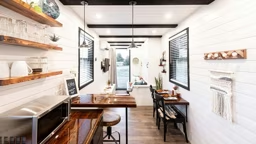
There are certain instances in life when it’s tough to know when to say when. For instance, when you’re dishing out a giant serving of ice cream. Or when you’ve been lounging all afternoon in the warm glow of the sun. Ice cream and sunshine are wonderful in moderation, but we all know that indulging in too much of a good thing isn’t good.
The same is true when it comes to determining how much wood to use inside a log home (or any other cabin for that matter).
For those who long for a lighter, brighter interior, or for those who simply want their framed photos to lay flat on their cabin’s wall, mixing in some drywall with the wood walls is appealing. Also, from a practical standpoint, installing kitchen and bathroom cabinets on drywall is far easier than on a rounded log surface.
See also Should You Renovate or Rebuild?
“Log Only” Crowd
Some hardcore log lovers argue that when it comes to wood, the more you’ve got, the better! Others may resist drywall for fear of losing the natural charm of their rustic home.
A cabin outfitted entirely in wall-to-wall wood can sometimes lack the energy of one that introduces contrasting elements. Using sheetrock or textured materials such as metal, glass, stucco, stone, copper or steel can add vigor to your décor.
For those who simply can’t bring themselves to drywall, take heart. There are many options for adding visual interest inside the cabin. A few ideas include:
- Installing painted cabinets
- Staining or painting window frames in complementary shades or colors
- Installing non-wood flooring, like slate, carpet or tile
- Incorporating rock or brick on walls or as a fireplace surround
- Breaking up large walls with framed mirrors to reflect natural light or bright wall hangings
- Use contrasting woods for a variety of textures and tones
“Every time you add a new texture to a room – a glass end table, a leather loveseat, a stone fireplace, a metal balcony railing, a copper wall sconce, etc. – you’re introducing a fresh layer of interest,” says Carrie Coffey, an interior design specialist at a Floor to Ceiling Interior Design showroom.
See also Detecting & Preventing Mold at the Cabin
Friends of Drywall
Most experts feel strongly that drywall enhances a log home’s character by adding color, dimension and flair to a home’s interior.
“In any room, you want to have differing elements of color and texture,” says Jean McCue of Love That Space design. “You can do that with drywall; it gives space a liveliness.”
In addition, overdosing on logs can make small rooms feel downright cramped. But the answer doesn’t lie in drywall alone. To open up a room, designers suggest using planked wood such as knotty pine on the ceiling and employing drywall on some walls. Another option is wainscoting (a decorative paneling adorning the lower half of the wall), which is a popular choice for stairways, dining rooms, bedrooms and bathrooms.
“You can actually obscure the beauty of logs if there isn’t anything to set it apart,” cautions McCue. “And showing off all that wood is ultimately what it’s all about.”










